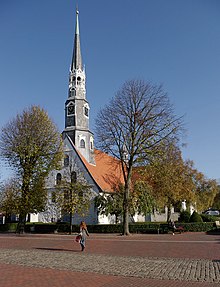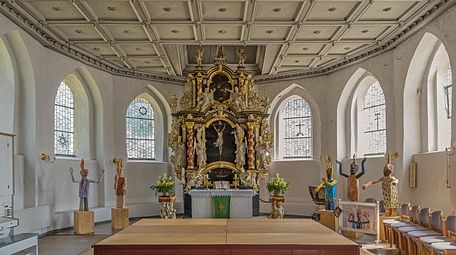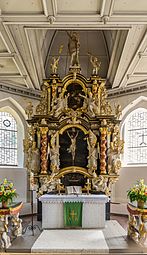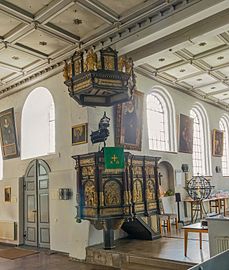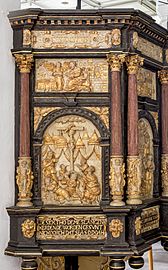St. Jürgen (Heath)
The St. Jürgen Church is an Evangelical Lutheran church in Heide (Holstein) . It stands in a central position on the southwest corner of the market square.
Building history
In 1435 a chapel was built in Heide, which was dedicated to St. George (St. Jürgen in Low German). When Heide was conquered by royal Danish and ducal troops during the Last Feud in 1559, the church burned down completely. Shortly afterwards, a new church was built on the old foundation walls, which was consecrated in 1560. In essence, this church has survived to this day, even if it has seen some changes.
It is an elongated hall church , whose masonry was first built from field stones and then continued with bricks . On the south side there is a large extension like a transept , an extension from the years 1694 to 1696. The 7/12 choir closure with supporting pillars is also the result of an extension that was made in 1724. At the beginning of the 19th century, a staircase in the classical style was added on the north side .
The west gable, renewed in 1739, has five arched windows and is structured by cornices . The sandstone relief above the central portal is a copy. The original from the 16th century has been inside the church since 1977. Christ risen from the grave is depicted. The figure of the donor can be seen at the bottom left.
Above the gable, drawn into the roof, rises a three-storey, slender wooden tower, which shows forms of the late Renaissance . The current appearance of the 48 meter high tower, built in 1611, goes back to a redesign in 1724. A much smaller, baroque roof turret can be seen further east on the roof , created in 1711 and renewed in 1911.
Interior and equipment
Because of the large arched windows (not originally) the interior of the church makes a light impression. The entire room is closed off by a coffered ceiling that was drawn in in 1880. Are on the north and west side of the ship galleries built.
- Altar structure
- The two-storey altar structure from 1699 shows high baroque forms. The work of art was created by the Hamburg altar carver Valentin Preuss, the paintings are by Johann Holte. The top is supported by twisted columns. Figures of angels and the four evangelists as well as inclined pilasters and lush acanthus frame the central painting, which depicts a crucifixion scene. Two smaller paintings show the Entombment of Christ (above) and the Last Supper (on the predella ). The work of art is crowned by the figure of the resurrected.
- Carved altar
- A Gothic carved altar in the form of a three-wing shrine is located on the south wall of the nave. The lamentation of Christ is shown in the middle compartment, while scenes with saints are depicted on the side wings, which are split across. You can see St. George, St. Andrew , John the Baptist and a bishop caring for the poor. Its current shape is probably the result of a combination of two medieval side altars from the previous church. The altars were created around 1515 by unknown masters of Upper German and Dutch training.
- pulpit
- The wooden pulpit is a work of the late Renaissance . It dates from the end of the 16th century and can be assigned to the Eiderstedter type. The four-sided cage shares a parapet with the entrance. This is divided into fields by columns on which reliefs with biblical scenes can be seen. Depicted above are Peter , Paul and the Evangelists, below the brazen serpent , the Annunciation of Mary, the Adoration of the Shepherds and the Magi, a group of the Cross and the Resurrection. The inscriptions below are in Low German.
- In addition to architectural decor, the hexagonal sound cover has figural reliefs depicting virtues and angels.
- crucifix
- A crucifix almost two meters high is attached to a wooden stand in the church between the nave and the annex. It is of late Gothic origin and dates from the end of the 15th century.
- To baptize
- In the extension there is a sandstone baptism from the middle of the 15th century with an octagonal, cup-like shape. The cup is reminiscent of a capital .
- There is also another baptism made of oak. This was created in 1641 by J. Heidtmann the Younger. In its basic structure it is hexagonal with a conical dome. Reliefs in the fields of the cup show the baptism of Christ, the Salvator and the four evangelists.
- chandelier
- Two brass chandeliers from the 17th century hang over the central aisle of the nave. They are richly decorated and crowned with a figure. The bowls under the candles are designed as scallops .
- North gallery
- The north gallery was built in the 17th century. It rests on wooden supports over which it protrudes a little. The overhang is supported by consoles between which two rows of dew band sleepers are mounted horizontally . A total of 43 oil paintings (on wood) with scenes from the Old and New Testament can be found on the parapet.
- Bells
- The older bell was cast by H. Prilop in 1540 and has an inscription and a frieze of foliage. It is made of bronze and is 86 cm high.
- The newer bell was cast by J. D. Kriesche in 1764 and also has a legend. It is made of bronze and has a diameter of 58 cm.
Gravestones on the church
In front of the church there are a number of old tombstones, of which the so-called atonement stone from 1567 is the oldest and most important. It is a sandstone slab measuring 2.10 m × 1.42 m on which a manslaughter carried out in 1567 is shown. One of two bearded men in hats stabs the other in the neck with a dagger.
literature
- Jochen Bufe: Churches in Dithmarschen. A topography by Jochen Bufe. Self-published 2010, Kirchenkreis Dithmarschen (editor)
- Georg Dehio: Handbook of German Art Monuments, Hamburg, Schleswig-Holstein. Edited by Johannes Habich, 1971, ISBN 3-422-00329-0
- Art topography Schleswig-Holstein. Processed in the State Office for Monument Preservation Schleswig-Holstein and in the Office for Monument Preservation of the Hanseatic City of Lübeck. Wachholtz, Neumünster 1982, ISBN 3-529-02627-1 .
Web links
Individual evidence
- ↑ a b Georg Dehio, Handbook of German Art Monuments, Hamburg, Schleswig-Holstein , edited by Johannes Habich, 1971, ISBN 3-422-00329-0 , p. 234
- ^ Art-Topography Schleswig-Holstein . Processed in the State Office for Monument Preservation Schleswig-Holstein and in the Office for Monument Preservation of the Hanseatic City of Lübeck. Wachholtz, Neumünster 1982, ISBN 3-529-02627-1 , p. 461
- ↑ http://www.suehnekreuz.de/holstein/heide.htm
Coordinates: 54 ° 11 ′ 39.9 ″ N , 9 ° 5 ′ 31 ″ E
